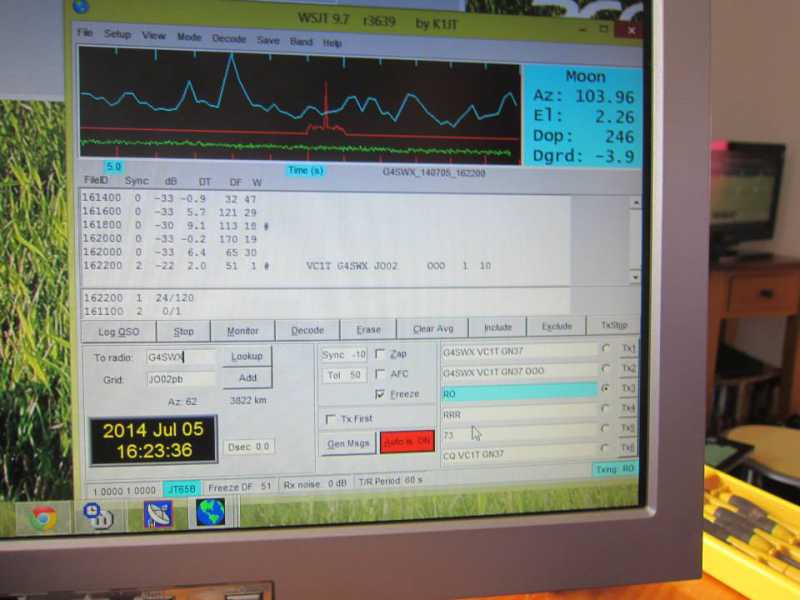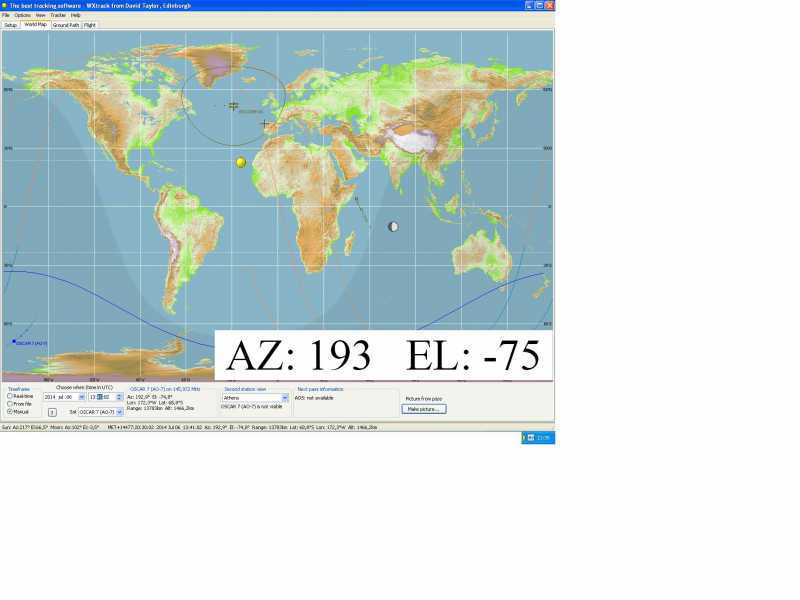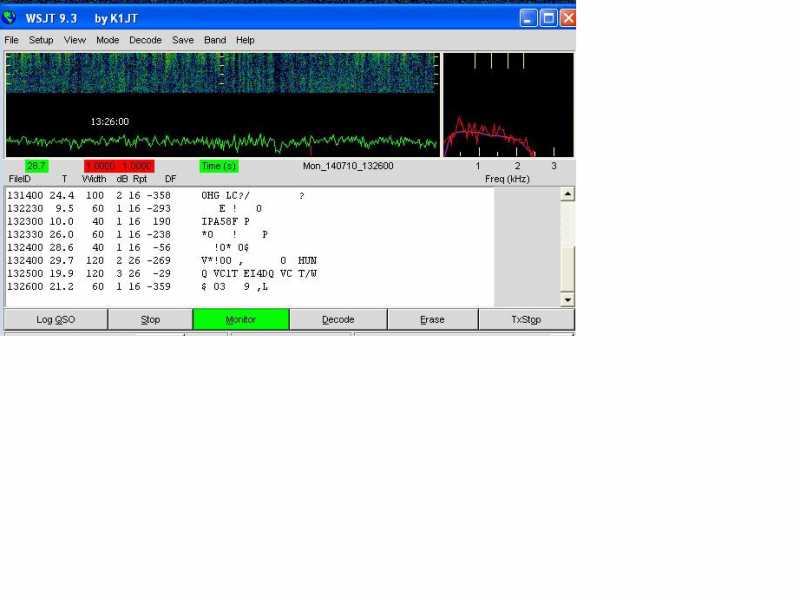No da muchos detalles técnicos, no sé si realmente se ha conseguido.En los chats de vhf no dicen nada al respecto.
Me corroe una terrible duda: Quedará algún español que todavía no se haya ido a la Mútua?.
Algo más de info....
...un screenshot de G4SWX:
http://www.g4cqm.co.uk/index2.html
...e info actualizada a diario por parte del grupo (photos incluidas!!!)
https://www.facebook.com/groups/727763137262407/
...si es cierto o no...como as meigas: habelas hailas!
73&DX de Zalo EB1IVY
Yo vi el spot en el cluster anunciandolo
Joaquín
http://ea2ccg.blogspot.com/
Que jodios, el EA Team tiene que superar eso 
73.
Mi hijo me hace profundamente feliz
TNX & 73,
Pedro EA4ADJ IM88jw http://ea4adj.jimdo.com/
La solana. Que pueblo, galan!
Hi Paul,
I am not so sure that a reception report can be classed as a ‘Result’ but perhaps more of a good indication that such things are possible.
I was the station that received the signals from VC1T yesterday afternoon. I was actually monitoring the backscatter reflections from the 5 or 6 stations that were calling VC1T. Although I have been one of those pioneering mixed mode, meteor scatter + tropospheric, tests over the last year I had thought that the 3823 (+/- a few), from VC1T to my station in Eastern England was a bit too far.
I have attached the WSJT screenshot from my PC for FSK441 yesterday afternoon.
At 13:32 UTC during the first 30 second period two successive meteor bursts from GM6VXB who was calling VC1T
At 13:41 UTC there are 3 successive meteor bursts during the second period the decode of the final one clearly showing CQ VC1T CQ
It is possible that this is reception of a ‘spoof’ transmission. However my reception was of meteor bursts and unless the person responsible was a long way away from the British Isles it is highly likely that continuous transmissions would have been seen by some of the many other stations monitoring.
So I am fairly sure that it was reception of the VC1T Canadian expedition team. Needless to say I warmed up my PA and called for the next 4 hours. During that time I received a partial CQ at 13:48 and something which was not decoded at 15:46.
For a couple of hours 18:00 - 20:00 my noise floor was degraded as the sun set through my antenna array! I continued monitoring until 22:30 UTC and although I saw a short reflection at 21:11 UTC I did not decode a full callsign. I have been monitoring since 06:10 today and although I have seen meteor reflections from 6 or so stations calling, I have seen nothing from across the Atlantic.
My ‘educated’ guess is the reception was probably due to a 2 hop E layer mode. My best guess is a combination of meteor scatter plus sporadic E. There is some supporting evidence for this. Also attached is a ‘live MUF’ map for 15:00 UTC which shows that 50Mhz was open across the Atlantic. In fact the tracks run through my location in JO02 and Newfoundland GN37. This 50MHz opening started around 13:00 UTC and continued for about 5 hours.
I have done a lot of work analysing historic 144MHz meteor scatter and sporadic E QSOs to find those with a potential tropospheric component. During this past year I have had 4 full meteor scatter + tropospheric QSOs over a 3040Km path to EA8TJ and EA8TX and about 6 incomplete QSOs.
From the tropospheric prediction maps, Hepburn & F5LEN during these QSOs I have developed a good picture of what was required. This was not in place yesterday during my reception of bursts from VC1T. the only stable area of the troposphere on the great circle path between England and Newfoundland was around 25 Deg West, pretty well the mid-point of the path. I guess that means that the sea will not be rough in that area !
My 144MHz amateur station is not exactly modest. I have 4 X 16 element Yagis on a 20m tower located in quiet rural surroundings. I have full UK licence power capability and operate mostly on 144MHz moonbounce and meteor scatter. For my pains I am also the RSGB’s VHF Manager!!!
Me corroe una terrible duda: Quedará algún español que todavía no se haya ido a la Mútua?.
Hola,
Bueno, pues habrá que esperar a ver el informe completo al final de la dxpedición, a ver si solo ha sido la recepción de una llamada, en una sola dirección, o si ha sido el QSO completo, en ambas direcciones con "R", etc.
Por otro lado eso de mezclar tropo con meteoritos con Es... no lo veo claro.
73, Máximo - EA1DDO
Máximo Martín - EA1DDO / HK1H / M0HAO
EA1DDO@HoTMaiL.com
http://www.EA1DDO.es
De momento parece ser que no ha habido contacto bilateral.
Desde mi qth he estado a la escucha varias horas y nada.Son 3.481 kms. Sería la única forma de conseguirlo, un cúmulo de circunstancias meteorológicas y de Es afortunadas.
Porqué no?. Una Es de doble salto ,una Es +tropo......
Una especie de cuento de la lechera.Pero si no se intenta no se consigue: "No pain no gain".
Me corroe una terrible duda: Quedará algún español que todavía no se haya ido a la Mútua?.
CHURRAS, MERIMNAS, :woohoo:
Fijaros donde estaba la ISS a las 13.41 el dia 6 👿 👿 👿 👿 👿 👿 👿 :whistle: :whistle: :whistle: :whistle: :whistle:
Escribió:Fijaros donde estaba la ISS a las 13.41 el dia 6
¿Sería ISS-Scatter ese contacto?
Máximo Martín - EA1DDO / HK1H / M0HAO
EA1DDO@HoTMaiL.com
http://www.EA1DDO.es
Habría que comprobar si la ISS estaba operativa en 144 en ese momento.
De lo contrario también valdría el contacto como nuevo record en la modalidad de
"Pedrolo contra objeto metálico".
Me corroe una terrible duda: Quedará algún español que todavía no se haya ido a la Mútua?.
[b]Ahora en serio:
Con la cantidad de chatarra espacial que circula sobre nuestras cabezas (Dios!!!, COMO LA URE PUEDE VIVIR SIN LANZAR SU PROPIO MICROSATELITE
como se puede garantizar si un contacto en vhf es efectuado via Es, via Ms, via airplane , via chatarra o via Es+chatarra?. :sick:[/b]
Me corroe una terrible duda: Quedará algún español que todavía no se haya ido a la Mútua?.
cuidado con lo que pides, se te olvida de donde sale la pasta.
EA1CCM escribió:cuidado con lo que pides, se te olvida de donde sale la pasta.
y a donde va...
Joaquín
http://ea2ccg.blogspot.com/
Escribió:** After reporting on the massive effort on the trans atlantic VHF
communication record news has broken during this week that this last
bastion of the VHF bands has been half conqured.Terry Gabriel, M0VRL, at Delabole, Cornwall, England, heard a weak JT65
signal, in and out of the noise, on 144,155 MHz around 11:53 UTC on
Saturday morning 5th July 2014, which occurred during the transatlantic
tests conducted by VC1T, a Canadian team. Terry has a big station and
shares an IARU Region 1 Tropo distance record of 4106 km with D44TD in
Cape Verde Islands, established on 144 MHz SSB. The distance between
VC1T, locator GN37os at Pouch Cove, Newfoundland, and M0VRL, locator
IO70po, is 3457 km! They are now using WSJT 9.7, which is the latest
digital version available and feeding 800 Watts into a 43 element Yagi
with a gain of 24 dBd.Breathtaking news occurred on July 6th at 13:41 UTC when John Regnault,
G4SWX VHF Manager of the RSGB, received a CQ meteor burst (FSK441 mode)
from VC1T. It was confirmed that the received burst was in the format
transmitted by VC1T. They started the 4 hours timeframe and no further
information on chat or e-mail exchanged. During that timeframe G4SWX
received 3 other bursts from which 2 were CQ and one other where only
the VC1T call sign was readable. Screenshots from WSJT are available as
well as maps from the current tropo situation on the North-Atlantic. The
Hepburn Forecasts of the North Atlantic have indicated very poor Tropo
Ducting conditions so far, but there is a chance that tropospheric
conditions could improve from 11 - 12 July 2014 when the tests come to
an end.A terrestrial two-way contact between North America and Europe has not
been achieved so far on 144 MHz, and it appears to be even more
challenging than making EME contacts over a total distance of 800 000 km
on this band.
Máximo Martín - EA1DDO / HK1H / M0HAO
EA1DDO@HoTMaiL.com
http://www.EA1DDO.es
QDURE - https://qsl.ure.es
Imprime y confirma tus QSL en tan solo tres click.
Nunca fue tan fácil y cómodo
el confirmar tus contactos.
TIENDA ONLINE URE
Publicaciones, mapas, polos, camisetas, gorras, tazas, forros polares y mucho más...
WEBCLUSTER EA4URE
Conoce el nuevo WebCluster de URE, ahora con nuevos filtros e información y compatible con GDURE





